Shicheng Li
Lumina-mGPT 2.0: Stand-Alone AutoRegressive Image Modeling
Jul 23, 2025Abstract:We present Lumina-mGPT 2.0, a stand-alone, decoder-only autoregressive model that revisits and revitalizes the autoregressive paradigm for high-quality image generation and beyond. Unlike existing approaches that rely on pretrained components or hybrid architectures, Lumina-mGPT 2.0 is trained entirely from scratch, enabling unrestricted architectural design and licensing freedom. It achieves generation quality on par with state-of-the-art diffusion models such as DALL-E 3 and SANA, while preserving the inherent flexibility and compositionality of autoregressive modeling. Our unified tokenization scheme allows the model to seamlessly handle a wide spectrum of tasks-including subject-driven generation, image editing, controllable synthesis, and dense prediction-within a single generative framework. To further boost usability, we incorporate efficient decoding strategies like inference-time scaling and speculative Jacobi sampling to improve quality and speed, respectively. Extensive evaluations on standard text-to-image benchmarks (e.g., GenEval, DPG) demonstrate that Lumina-mGPT 2.0 not only matches but in some cases surpasses diffusion-based models. Moreover, we confirm its multi-task capabilities on the Graph200K benchmark, with the native Lumina-mGPT 2.0 performing exceptionally well. These results position Lumina-mGPT 2.0 as a strong, flexible foundation model for unified multimodal generation. We have released our training details, code, and models at https://github.com/Alpha-VLLM/Lumina-mGPT-2.0.
MiMo: Unlocking the Reasoning Potential of Language Model -- From Pretraining to Posttraining
May 12, 2025Abstract:We present MiMo-7B, a large language model born for reasoning tasks, with optimization across both pre-training and post-training stages. During pre-training, we enhance the data preprocessing pipeline and employ a three-stage data mixing strategy to strengthen the base model's reasoning potential. MiMo-7B-Base is pre-trained on 25 trillion tokens, with additional Multi-Token Prediction objective for enhanced performance and accelerated inference speed. During post-training, we curate a dataset of 130K verifiable mathematics and programming problems for reinforcement learning, integrating a test-difficulty-driven code-reward scheme to alleviate sparse-reward issues and employing strategic data resampling to stabilize training. Extensive evaluations show that MiMo-7B-Base possesses exceptional reasoning potential, outperforming even much larger 32B models. The final RL-tuned model, MiMo-7B-RL, achieves superior performance on mathematics, code and general reasoning tasks, surpassing the performance of OpenAI o1-mini. The model checkpoints are available at https://github.com/xiaomimimo/MiMo.
TimeChat-Online: 80% Visual Tokens are Naturally Redundant in Streaming Videos
Apr 24, 2025Abstract:The rapid growth of online video platforms, particularly live streaming services, has created an urgent need for real-time video understanding systems. These systems must process continuous video streams and respond to user queries instantaneously, presenting unique challenges for current Video Large Language Models (VideoLLMs). While existing VideoLLMs excel at processing complete videos, they face significant limitations in streaming scenarios due to their inability to handle dense, redundant frames efficiently. We introduce TimeChat-Online, a novel online VideoLLM that revolutionizes real-time video interaction. At its core lies our innovative Differential Token Drop (DTD) module, which addresses the fundamental challenge of visual redundancy in streaming videos. Drawing inspiration from human visual perception's Change Blindness phenomenon, DTD preserves meaningful temporal changes while filtering out static, redundant content between frames. Remarkably, our experiments demonstrate that DTD achieves an 82.8% reduction in video tokens while maintaining 98% performance on StreamingBench, revealing that over 80% of visual content in streaming videos is naturally redundant without requiring language guidance. To enable seamless real-time interaction, we present TimeChat-Online-139K, a comprehensive streaming video dataset featuring diverse interaction patterns including backward-tracing, current-perception, and future-responding scenarios. TimeChat-Online's unique Proactive Response capability, naturally achieved through continuous monitoring of video scene transitions via DTD, sets it apart from conventional approaches. Our extensive evaluation demonstrates TimeChat-Online's superior performance on streaming benchmarks (StreamingBench and OvOBench) and maintaining competitive results on long-form video tasks such as Video-MME and MLVU.
QAMA: Quantum annealing multi-head attention operator with classical deep learning framework
Apr 15, 2025Abstract:As large language models scale up, the conventional attention mechanism faces critical challenges of exponential growth in memory consumption and energy costs. Quantum annealing computing, with its inherent advantages in computational efficiency and low energy consumption, offers an innovative direction for constructing novel deep learning architectures. This study proposes the first Quantum Annealing-based Multi-head Attention (QAMA) mechanism, achieving seamless compatibility with classical attention architectures through quadratic unconstrained binary optimization (QUBO) modeling of forward propagation and energy-based backpropagation. The method innovatively leverages the quantum bit interaction characteristics of Ising models to optimize the conventional $O(n^2)$ spatiotemporal complexity into linear resource consumption. Integrated with the optical computing advantages of coherent Ising machines (CIM), the system maintains millisecond-level real-time responsiveness while significantly reducing energy consumption. Our key contributions include: Theoretical proofs establish QAMA mathematical equivalence to classical attention mechanisms; Dual optimization of multi-head specificity and long-range information capture via QUBO constraints; Explicit gradient proofs for the Ising energy equation are utilized to implement gradient conduction as the only path in the computational graph as a layer; Proposed soft selection mechanism overcoming traditional binary attention limitations to approximate continuous weights. Experiments on QBoson CPQC quantum computer show QAMA achieves comparable accuracy to classical operators while reducing inference time to millisecond level and improving solution quality. This work pioneers architectural-level integration of quantum computing and deep learning, applicable to any attention-based model, driving paradigm innovation in AI foundational computing.
Every FLOP Counts: Scaling a 300B Mixture-of-Experts LING LLM without Premium GPUs
Mar 07, 2025



Abstract:In this technical report, we tackle the challenges of training large-scale Mixture of Experts (MoE) models, focusing on overcoming cost inefficiency and resource limitations prevalent in such systems. To address these issues, we present two differently sized MoE large language models (LLMs), namely Ling-Lite and Ling-Plus (referred to as "Bailing" in Chinese, spelled B\v{a}il\'ing in Pinyin). Ling-Lite contains 16.8 billion parameters with 2.75 billion activated parameters, while Ling-Plus boasts 290 billion parameters with 28.8 billion activated parameters. Both models exhibit comparable performance to leading industry benchmarks. This report offers actionable insights to improve the efficiency and accessibility of AI development in resource-constrained settings, promoting more scalable and sustainable technologies. Specifically, to reduce training costs for large-scale MoE models, we propose innovative methods for (1) optimization of model architecture and training processes, (2) refinement of training anomaly handling, and (3) enhancement of model evaluation efficiency. Additionally, leveraging high-quality data generated from knowledge graphs, our models demonstrate superior capabilities in tool use compared to other models. Ultimately, our experimental findings demonstrate that a 300B MoE LLM can be effectively trained on lower-performance devices while achieving comparable performance to models of a similar scale, including dense and MoE models. Compared to high-performance devices, utilizing a lower-specification hardware system during the pre-training phase demonstrates significant cost savings, reducing computing costs by approximately 20%. The models can be accessed at https://huggingface.co/inclusionAI.
Lumina-Video: Efficient and Flexible Video Generation with Multi-scale Next-DiT
Feb 10, 2025Abstract:Recent advancements have established Diffusion Transformers (DiTs) as a dominant framework in generative modeling. Building on this success, Lumina-Next achieves exceptional performance in the generation of photorealistic images with Next-DiT. However, its potential for video generation remains largely untapped, with significant challenges in modeling the spatiotemporal complexity inherent to video data. To address this, we introduce Lumina-Video, a framework that leverages the strengths of Next-DiT while introducing tailored solutions for video synthesis. Lumina-Video incorporates a Multi-scale Next-DiT architecture, which jointly learns multiple patchifications to enhance both efficiency and flexibility. By incorporating the motion score as an explicit condition, Lumina-Video also enables direct control of generated videos' dynamic degree. Combined with a progressive training scheme with increasingly higher resolution and FPS, and a multi-source training scheme with mixed natural and synthetic data, Lumina-Video achieves remarkable aesthetic quality and motion smoothness at high training and inference efficiency. We additionally propose Lumina-V2A, a video-to-audio model based on Next-DiT, to create synchronized sounds for generated videos. Codes are released at https://www.github.com/Alpha-VLLM/Lumina-Video.
PunchBench: Benchmarking MLLMs in Multimodal Punchline Comprehension
Dec 16, 2024



Abstract:Multimodal punchlines, which involve humor or sarcasm conveyed in image-caption pairs, are a popular way of communication on online multimedia platforms. With the rapid development of multimodal large language models (MLLMs), it is essential to assess their ability to effectively comprehend these punchlines. However, existing benchmarks on punchline comprehension suffer from three major limitations: 1) language shortcuts that allow models to solely rely on text, 2) lack of question diversity, and 3) narrow focus on a specific domain of multimodal content (e.g., cartoon). To address these limitations, we introduce a multimodal \textbf{Punch}line comprehension \textbf{Bench}mark, named \textbf{PunchBench}, which is tailored for accurate and comprehensive evaluation of punchline comprehension. To enhance the evaluation accuracy, we generate synonymous and antonymous captions by modifying original captions, which mitigates the impact of shortcuts in the captions. To provide a comprehensive evaluation, PunchBench incorporates diverse question formats and image-captions from various domains. On this basis, we conduct extensive evaluations and reveal a significant gap between state-of-the-art MLLMs and humans in punchline comprehension. To improve punchline comprehension, we propose Simple-to-Complex Chain-of-Question (SC-CoQ) strategy, enabling the models to incrementally address complicated questions by first mastering simple ones. SC-CoQ effectively enhances the performance of various MLLMs on PunchBench, surpassing in-context learning and chain-of-thought.
TempCompass: Do Video LLMs Really Understand Videos?
Mar 01, 2024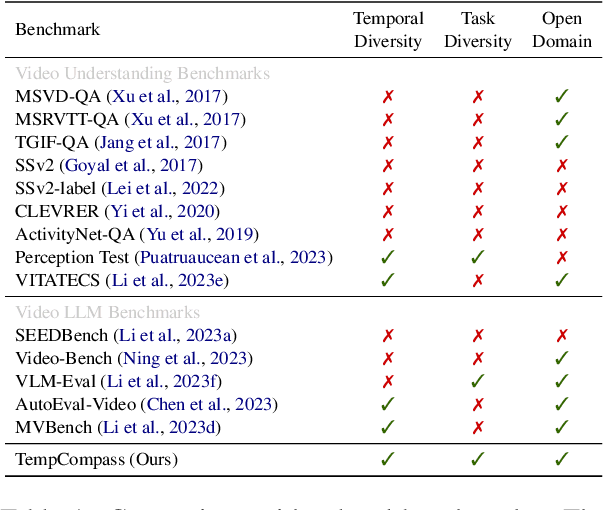
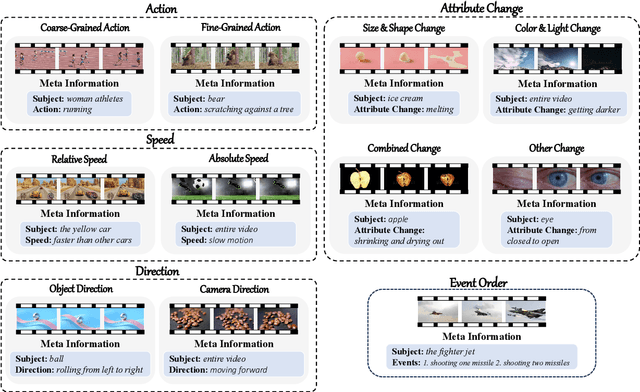
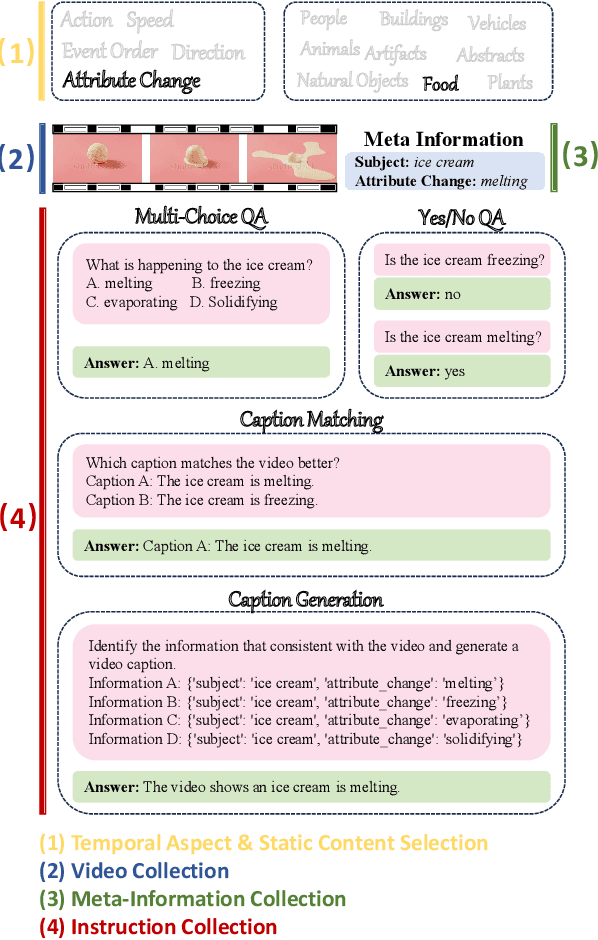
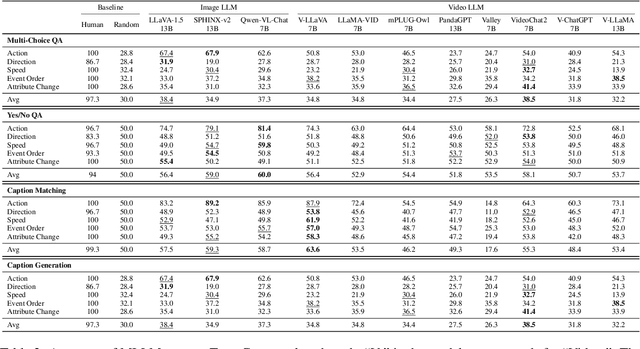
Abstract:Recently, there is a surge in interest surrounding video large language models (Video LLMs). However, existing benchmarks fail to provide a comprehensive feedback on the temporal perception ability of Video LLMs. On the one hand, most of them are unable to distinguish between different temporal aspects (e.g., speed, direction) and thus cannot reflect the nuanced performance on these specific aspects. On the other hand, they are limited in the diversity of task formats (e.g., only multi-choice QA), which hinders the understanding of how temporal perception performance may vary across different types of tasks. Motivated by these two problems, we propose the \textbf{TempCompass} benchmark, which introduces a diversity of temporal aspects and task formats. To collect high-quality test data, we devise two novel strategies: (1) In video collection, we construct conflicting videos that share the same static content but differ in a specific temporal aspect, which prevents Video LLMs from leveraging single-frame bias or language priors. (2) To collect the task instructions, we propose a paradigm where humans first annotate meta-information for a video and then an LLM generates the instruction. We also design an LLM-based approach to automatically and accurately evaluate the responses from Video LLMs. Based on TempCompass, we comprehensively evaluate 8 state-of-the-art (SOTA) Video LLMs and 3 Image LLMs, and reveal the discerning fact that these models exhibit notably poor temporal perception ability. Our data will be available at \url{https://github.com/llyx97/TempCompass}.
TimeChat: A Time-sensitive Multimodal Large Language Model for Long Video Understanding
Dec 04, 2023
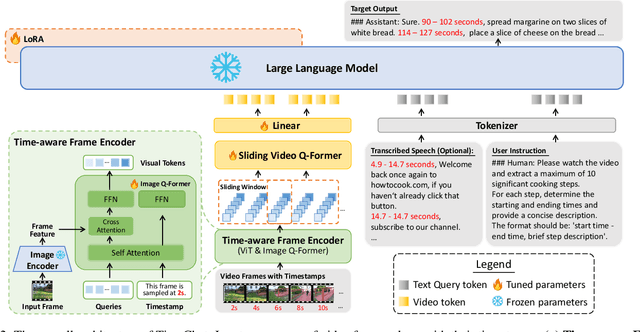

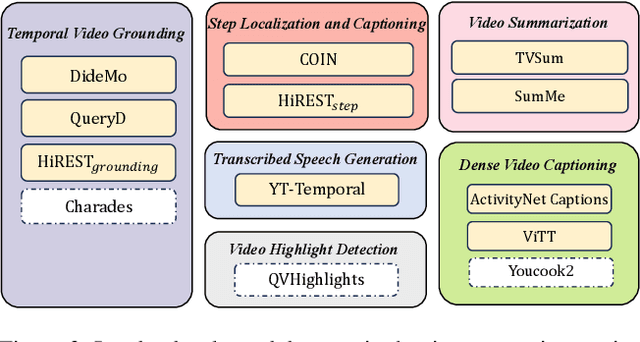
Abstract:This work proposes TimeChat, a time-sensitive multimodal large language model specifically designed for long video understanding. Our model incorporates two key architectural contributions: (1) a timestamp-aware frame encoder that binds visual content with the timestamp of each frame, and (2) a sliding video Q-Former that produces a video token sequence of varying lengths to accommodate videos of various durations. Additionally, we construct an instruction-tuning dataset, encompassing 6 tasks and a total of 125K instances, to further enhance TimeChat's instruction-following performance. Experiment results across various video understanding tasks, such as dense captioning, temporal grounding, and highlight detection, demonstrate TimeChat's strong zero-shot temporal localization and reasoning capabilities. For example, it achieves +9.2 F1 score and +2.8 CIDEr on YouCook2, +5.8 HIT@1 on QVHighlights, and +27.5 R@1 (IoU=0.5) on Charades-STA, compared to state-of-the-art video large language models, holding the potential to serve as a versatile video assistant for long-form video comprehension tasks and satisfy realistic user requirements.
VITATECS: A Diagnostic Dataset for Temporal Concept Understanding of Video-Language Models
Nov 29, 2023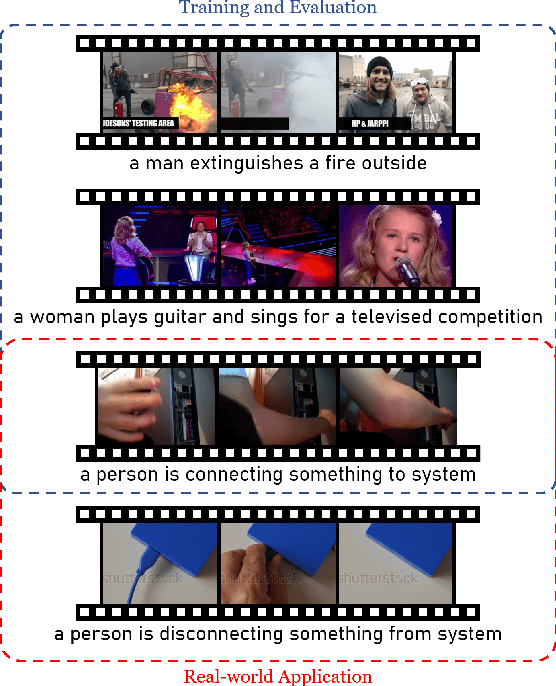

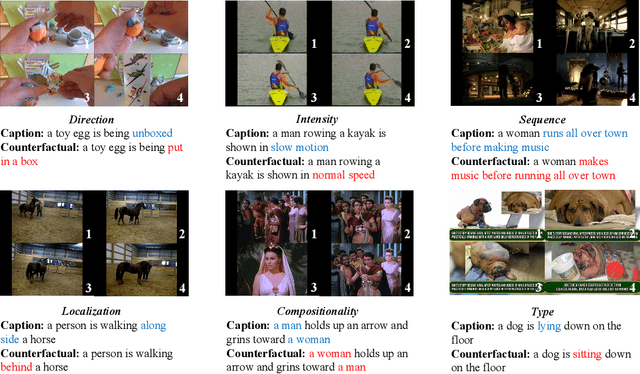

Abstract:The ability to perceive how objects change over time is a crucial ingredient in human intelligence. However, current benchmarks cannot faithfully reflect the temporal understanding abilities of video-language models (VidLMs) due to the existence of static visual shortcuts. To remedy this issue, we present VITATECS, a diagnostic VIdeo-Text dAtaset for the evaluation of TEmporal Concept underStanding. Specifically, we first introduce a fine-grained taxonomy of temporal concepts in natural language in order to diagnose the capability of VidLMs to comprehend different temporal aspects. Furthermore, to disentangle the correlation between static and temporal information, we generate counterfactual video descriptions that differ from the original one only in the specified temporal aspect. We employ a semi-automatic data collection framework using large language models and human-in-the-loop annotation to obtain high-quality counterfactual descriptions efficiently. Evaluation of representative video-language understanding models confirms their deficiency in temporal understanding, revealing the need for greater emphasis on the temporal elements in video-language research.
 Add to Chrome
Add to Chrome Add to Firefox
Add to Firefox Add to Edge
Add to Edge